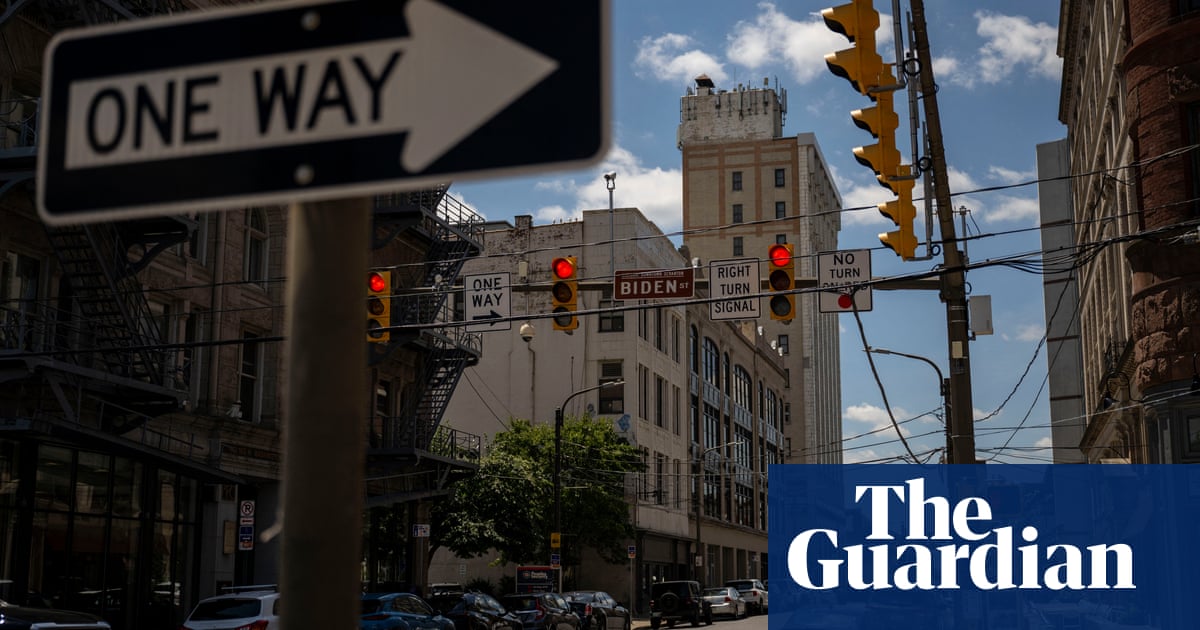The annual Downtown on Ice festival is under way in Scranton, Pennsylvania. Ice sculptures are dotted around the city – there was little chance of them melting as an Arctic blast pulled temperatures down to 15F (-9C).
Inside Boscov’s, a 100-year-old department store, Sue Sloan says she can’t wait for spring. The 60–year-old housekeeper says she’s also looking for other changes. “Everything is so expensive,” she says. “Food prices, eggs, meat, gas, electricity, everything. It’s terrible,” she says.
Sentiments like that helped Donald Trump deliver arguably the most humiliating defeat to Joe Biden’s administration in last year’s election. Scranton is Biden’s home town, and the local electorate not only turned out against his hand-picked successor, Kamala Harris, but the long-term local Democratic representatives Congressman Matt Cartwright and Senator Bob Casey.
Bidenomics – Biden’s economic platform – earmarked billions for the state, but still Trump’s economic messaging on everyday prices won the day.
“It’s 100% the economy all day long. The economy was the 800lb gorilla in this campaign,” says Rob Bresnahan, newly installed Republican congressman for Pennsylvania’s eighth congressional district.
Earlier that day Bresnahan had been discussing what to do about a 10.8% hike in gas prices from UGI, a local utility. “People can’t afford to exist. People are having to decide between heating their homes or putting food in their refrigerators,” he says.
But in one of the great puzzles of the 2024 election, some in the area – not all of them Democrats – say the local economy is great. For them, Trump’s messaging was at best misleading.
Bob Durkin, president of the Greater Scranton Chamber of Commerce, says business in the area has rarely been better. “This local economy is in really good shape,” says Durkin. Developers have bought every building downtown. Scaffolding is everywhere, covering some of the handsome neoclassical and art nouveau buildings constructed during Scranton’s heyday at the turn of the 20th century. Once unloved, they are being turned into offices, lofts and retail space.
New employers are coming to the area attracted by its lower cost of living and proximity to New York. New restaurants and bars are popping up across the city and attracting crowds even in frigid late January. On the surface the self-styled “Electric City” – Scranton was one of the first cities to have electric lights and streetcars – is shining bright. Durkin’s major concern is shaking off people’s outdated perceptions of Scranton as a failing coal town and finding enough people to fill the jobs employers have, he says.
But a fissure has developed between the economy and people’s experience of it. Ahead of the election, poll after poll showed that voters were unhappy with the economy, even as it recovered from the depths of the Covid recession. It’s been a global phenomenon brought on by people’s intense dislike of inflation, which soared after the pandemic, and one that has humbled incumbent governments worldwide.
Durkin says inflation was “the worst” but the US has fared better than most other countries in the recovery.
“I want to be careful what I say here,” he says. “I think people should see it for what it is. It was just a bunch of people saying things that weren’t really true. I mean inflation, yes. The cost of goods was high, but it was high all over the globe. I try to avoid getting involved in anything partisan, but when you look at all the standard measures that anybody would look to, the American economy is humming.”
Inflation fell faster in the US, growth picked up quicker, he says. “We just had a bunch of people saying it wasn’t true.”
Bresnahan could not disagree more. “The medium household income of my district is $61,000 a year. You’re talking about the S&P, the Nasdaq, the majority of people [in this area] are living paycheck to paycheck. When you are being told time and time again that the economy is booming and we are sitting around with our family deciding whether we can take that vacation this year … we are calling bullcrap.”
For now, Republicans can point the finger at the Biden administration for the national feeling of malaise that had so many hungry for change. But many of the issues facing Scranton – and large swathes of the US – go back decades, and will prove tough to solve. Many administrations have overseen the decline of well-paid manufacturing jobs, stagnant wage growth, soaring housing costs, lack of affordable childcare. As in other areas across the US, Scranton’s economic boom and influx of new workers have exacerbated existing issues, such as the lack of affordable housing for lower-paid long-term residents.
“When I win, I will immediately bring prices down, starting on day one,” Trump promised. It’s early days, but so far his major policy plan to bring down prices has been to call for more oil drilling – a plan some experts dispute will work.
For some locals, change can’t come soon enough. Bresnahan says lowering energy prices will go a long way to tackling the cost of living crisis. “There were economic implications for vilifying natural resources,” he says.
Republican voters, the group most concerned about the economy under Biden, are now warming to the economy under Trump, according to early polling. “We are only a week into Trump’s new term, and already Republicans are more confident in the economy today than Democrats were of Biden’s leading into the election. While economic views flip with a new party in office, there’s more energy here early on and that’s worth watching,” says John Gerzema, the CEO of Harris Poll.
But there is a long way to go, and, locally, there is deep scepticism that Trump will pull it off.
Kenneth Minor, 65, is on social security. “Everything has gone up. People are angry. Why wouldn’t they be?” he says. But he doesn’t think Trump will improve matters. “I just had to put $60 in my ex-wife’s bank account just to keep it open. You think Trump and his billionaire pals ever had to do that?”
It’s a sentiment Paige Cognetti, the city’s Democratic mayor, says she hears a lot. For Cognetti, the election underscored the difference between how some politicians, economists and business leaders viewed the macroeconomy and “how families feel at their kitchen tables. It can be true that we have really positive trajectories, investment dollars are going in to places like Scranton. There’s a good business case, new restaurants, new shops. And also people feel their wages are not keeping up, they feel that bills are too high. Both of those things are true at the same time.”
Part of the difficulties some politicians had in the election cycle was acknowledging one while not acknowledging the other, she says. “We do have positive growth, but at the same time we have folks who are really feeling the pinch at home.”
Now hanging over that recovery, she says, is the specter of tariffs – Trump’s other major economic platform. The president said he would impose tariffs on 1 February on products from Canada, Mexico and China, countries that account for more than a third of US trade.
“Are avocados going to be even more expensive? Are we going to have mass deportations in the Fresno area [that add to agricultural costs]? We are all now on the train, and it’s hard to imagine that it doesn’t lead to a higher cost of living,” says Cognetti.
Bresnahan says he wants to see the details on any tariff proposals before voting on them. “I understand conceptually what tariffs are meant to do, but I ran on making life more affordable again,” he says. “Any policies that are going to increase the cost for the average family, I am going to have a really hard time getting behind.”
The congressman caucuses with the “problem-solvers” – a House group that tries to foster bipartisan cooperation. But like many Republicans before him, he may find Trump too has a “hard time” with representatives who don’t get behind his plans.
The Republican victory in this region was clear but narrow. Bresnahan beat incumbent Matt Cartwright 50.8% to 49.2%. Trump’s 2024 winning margin was the fourth smallest since 1960 on a percentage basis. It’s too early to say whether Trumponomics will prove more popular than Bidenomics or whether the new president’s tariff threats will make America great or derail the economy.
But it is clear that in the town that kicked out its hometown boy, voters are ready to do the same to Trump if he doesn’t pull through.
With an icy wind whistling up Biden Street, Mike Johnson, 52, says he doesn’t have long to chat. He describes the economy as “meh” – he’s working, but declines to say where, and says everyone he knows says life has become too expensive.
“People wanted change,” he says. “Joe was too old and I didn’t feel like Harris had the answers. But I can’t stand Trump, and we’ll kick him out too if things don’t get better.”










